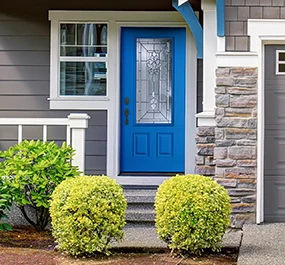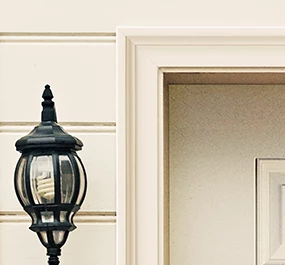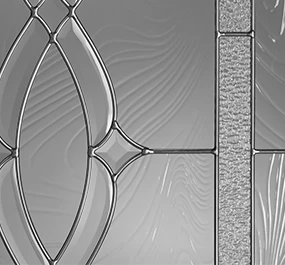Wood, steel, fiberglass—oh my. There are a variety of materials to consider when choosing your home’s exterior door, and each type differs when it comes to appearance, cost, and more. So how do you choose between wood vs. fiberglass vs. steel doors for your home? Enter our comparison guide.
The top three contenders: wood, steel, and fiberglass
If you’re looking at new exterior doors, it’s likely you’re choosing between three types of material: wood vs. fiberglass vs. steel doors. Each has unique properties, and one type may be better suited to your home than the others.
Wood doors are one of the most popular materials based on their aesthetic appeal, while steel are typically the least chosen doors for the same reason. Wood door popularity has withstood the test of time (while the use of steel has waxed and waned).
Few materials have risen the ranks and evolved as well as fiberglass. Developed using polyester resin in the early 1900s, fiberglass doors were born and have become a common choice for American homes in recent decades. A number of factors will determine if wood vs. fiberglass vs. steel doors are right for your home, including the appearance, cost, durability, energy efficiency, and security of each.
1. Appearance
Wood entryway doors are known for being visually appealing, traditional, and easily customizable.
Steel doors, on the other hand, are widely considered the least adaptable. Most steel doors feature a smooth surface and less defined panel embossments, resulting in lesser curb appeal compared to wood and fiberglass. Steel doors are prone to dents and rust and can’t be stained like wood or fiberglass, they need to be painted, and possibly repainted.
Fiberglass doors offer the best of both worlds and act as a good compromise between wood and steel. These doors have evolved to mimic the look of wood graining, come in various styles, feature well-defined panel embossments, and can be stained or painted depending on the skin to suit homeowner preference or architectural style.
2. Cost
Price is a major factor in deciding what you’ll invest in for your home—and what you can live without. Your entryway door is one of the first things guests will see, and choosing one you love (and won’t have to replace) is important.
The pillars of exterior door cost are two-fold: one, the upfront cost of the material and two, the longevity and cost-per-use of the door, how long it will last before needing touch-ups, repairs, or a full-on replacement. Each of these costs is important in comparing wood vs. fiberglass vs. steel doors.
There are a variety of factors that could affect the pricing of a door unit: door materials, slab size, unit configuration, doorlite glass, hardware, jamb materials, and other custom features. In this article, we will only be discussing the door slab material and how that affects the price. Always check with your local supplier for the most current and accurate cost.
A wood door slab will run you anywhere from $500-$5,000, with wooden doors typically starting at a higher price point than steel or fiberglass if you’re working with quality wood. The pricing could also vary depending on the type of wood and slab sizes.
Basic steel door cost ranges from $200-$1,500 or more. And while steel doors require less upkeep than their wood counterparts, severe weather conditions can lead to dents and rust, which are tough to repair and may require a full door replacement.
Basic fiberglass entry door prices might start around $500, and more elaborate doors can run as high as $3,000. But what fiberglass doors cost upfront, they make up for with their high performance and durability. Fiberglass doors can last decades with minimal maintenance, making them an excellent investment for your home.
3. Durability
Cost efficiency and door durability go hand-in-hand—the more durable your front door, the better it will withstand harsh conditions and the more money it’ll save you in the long run.
Wooden doors are highly susceptible to weather and are privy to scratches, dents, warping, and moisture damage, which is why they only last an average of 10-30 years, depending on the type of wood, weather conditions, and how constantly it is maintained. This range assumes they don’t encounter significant, unanticipated damage, as high heat and humidity will warp the wood and exposure to moisture will lead to rotting or mold on a much quicker timeline, leading to a full replacement.
Steel seems to be a more economical and sturdy option than wood and fiberglass at the beginning of its life, but steel is more susceptible to damage in the long-term than either other material: it is more prone to being dented or scratched than fiberglass and some wood. Depending on the type of core a steel door has, condensation may build up inside the door and cause the door to rust from the inside. These issues can cause an unattractive appearance, rust on both the interior and exterior, and other moisture damage. Steel also isn’t easy to repair, so these durability issues often end up necessitating a complete door replacement. However, if unimpacted and well maintained, steel doors should last at least 30 years.
Fiberglass doors offer the best weather resistance and aren’t prone to the types of damage wood and steel are, making them a longer-lasting option for an exterior door. These doors are made with durability in mind, with a composite exterior and fiberglass door skin that repels water and resists warping, rotting, and cosmetic damage. This design leads to increased longevity—they can last 50 years or more if taken care of—without chipping or denting like wood and steel. Speciality impact doors are an option to add durability in areas with extreme hurricane conditions—they can withstand elements such as flying debris and high wind speeds.
4. Energy Efficiency
Energy-efficient exterior doors help reduce heating and cooling costs in your home, so this is another important factor to consider when determining the long-term energy cost and consequences of your front door selection.
Searching for an energy-efficient door can be complicated- several key factors to keep in mind are Solar Heat Gain Coefficient (SHGC), U-Factor, and R-Value. The SHGC reflects the product’s ability to resist indirect solar radiation- in warmer climates a lower SHGC will help keep the indoors cool, but in cooler climates a higher SHGC can help to keep the home warm. The U-Factor rating measures how well a product keeps heat trapped inside- look for a low number. R-values measure a product’s resistance to heat loss- look for a higher R-Value.
Wood doors have relatively poor insulation and are the least energy efficient when comparing wood vs. fiberglass vs. steel doors. Natural wood is more likely to disperse heat from the indoors to the outside and vice versa than steel or fiberglass.
Steel doors are more energy-efficient than wood, and can also outperform fiberglass when made properly with a good thermal break and filled with high-density, polyurethane foam. Steel is the strongest temperature conductor, meaning that it is most likely to be affected by the weather. However, the door can be extremely cold in the winter as well as burning hot in the summer—and this extends to your home. Therefore, if a steel door is not built properly, it will not perform well at conserving energy.
However, even though some steel doors will outperform fiberglass in regards to U-factor, fiberglass doors are still top-rated when it comes to energy efficiency. Like steel doors, when their foam cores are high-quality and tightly packed, they provide strong insulation and help maintain consistent temperature, which ultimately will lower your energy bill in any season.
5. Security
One of the largest concerns buyers have when looking for an exterior door is security. Which door will keep you safest from an intruder, and which will literally crack under the pressure? When it comes to wood vs. fiberglass vs. steel doors, the answer largely depends on your material and hardware choice.
Wood doors’ resistance to breaking under tension will depend on the quality and type of wood selected—softer woods are the least secure and most likely to break under impact.
Steel is dense, so it’s extremely difficult to force open. But while steel doors are revered as secure, not all are of equal strength—larger retailers often sell lower-strength, 24- to 26-gauge steel that’s about as thick as a soda can, while select manufacturers sell far more supportive steel at 18+-gauge thickness.
Because of their durability and dense cores, fiberglass doors are a great choice to improve front door security. The thicker, fiberglass skin when combined with a rigid, tightly packed foam core strengthens fiberglass door against forced entry. Plastpro’s fiberglass doors offer this high-density, polyurethane foam core and also feature an extended, full-length lockblock that reinforces the door’s structural rigidity and allows the installation of a wide range of hardware. Plastpro also offers composite door frames, which are significantly more durable and rigid than wood frames, and therefore more reliable at keeping your door on its hinges.
Check out Plastpro’s Where to Buy page to find the closest distributor for fiberglass doors. For more information on our fiberglass door offerings, visit our website.



